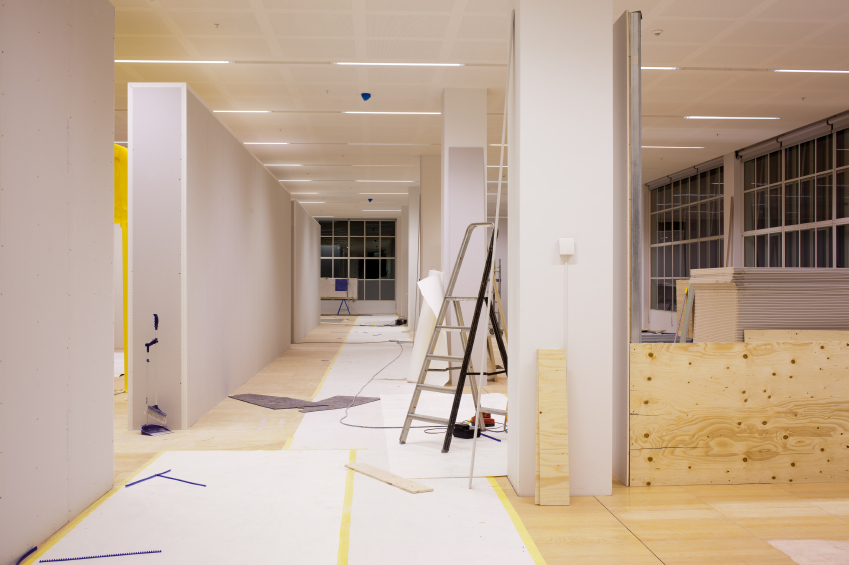When searching for your ideal workspace, it’s practically impossible to find exactly what you want in ready-to-move-in condition. Most spaces will require some type of office buildout. Sometimes it may be nothing more than some new carpet and paint. Other times it may involve knocking down some walls, building new walls, or other major renovations. Understandably, the cost of such tenant buildouts can be a concern for any company. These costs; however, are completely negotiable. In fact, the landlord can potentially pay for many of them as long as certain financials and obligations are met. In this post, we present a few general rules of thumb regarding office buildouts, what the terms “tenant finsh out” or “tenant build outs” mean, the cost of tenant improvements, and who pays what.
What Is a Tenant or Office Build Out?
The definition of tenant or office buildout is when a landlord’s contractor, or a contractor of the tenant’s choosing, must renovate a leased space prior to tenant occupancy. These renovations can include anything from tearing down or building walls, laying down carpeting, interior painting, upgrading an HVAC system, or installing lighting, plumbing, or fixtures. The term tenant build out is often used interchangeably with terms like tenant improvements or a tenant finish out.
Who Pays For Tenant Buildouts/Improvements?
Who pays for an office buildout depends on how the lease is negotiated and written up. There are some cases where a landlord may cover 100 percent of the cost of a standard tenant build out. High-end improvements may result in more out-of-pocket expenses.
Who manages the tenant improvement process depends on the project’s size and scope. The landlord or their property manager typically oversees most of the smaller renovations. Their chosen contractor usually handles most of the actual project management responsibilities – basically just reporting to them.
When it comes to larger office buildouts, it’s not uncommon for the tenant to want the option to choose their own contractor or have their own project manager assigned to the project.
There are three primary ways to go about negotiating tenant improvements. These are a “building standard” allowance, a landlord turnkey job, or a tenant improvement allowance.
Standard Office Build Out
In this scenario, the landlord offers to pay 100 percent towards a specified package of improvements. You are likely to be presented this approach in a new building where the landlord already has a construction crew and materials on-site. The “building standard” can include anything from the type of drop-ceiling, carpeting, and flooring to a set number of lights per square feet, drywall partitions, and coats of paint. If anything fancier is wanted, the tenant pays the difference. While you’re responsible for anything more high-end, the landlord assumes responsibility for any project overrun or timeline delay.
Turnkey Office Build Out
This arrangement has the landlord building out the space per the tenant’s specifications and also covering the costs. It’s called turnkey because all the tenant has to do to move in is turn the key. The tenant and landlord must work with an architect or contractor to come to a mutually agreeable design plan while the lease is being negotiated. The downside to this option is it’s not uncommon for some landlords to cut corners when it comes to materials or hired help. That said, if the space you’re leasing is smaller than 10,000 square feet, or you’re only signing a short term lease, a turnkey TI arrangement should work out just fine for you. Just always keep in mind that the landlord offering this type of deal is recovering what they’re spending one way or the other. Whether they’re charging more in rent or they’re using a local commercial construction contractor giving them a pricing break that isn’t necessarily being passed onto you.
Tenant Improvement Allowance
This scenario gives much greater control to the tenant. The tenant chooses everything from the architect and contractor hired to the finishes, etc. A tenant improvement allowance (TI allowance) is agreed upon during lease negotiations. This amount is generally contingent on the lease’s length and the tenant’s financial position. Many times the tenant might pay the upfront costs. Their TI allowance is then paid upon the completion of work subject to certain conditions being met.
Before lease negotiations are finalized, the tenant should get several preliminary construction bids to ensure the TI allowance they agree to is enough to cover improvements. This also lets them know exactly how much they’ll need to come up with out of pocket.
This option is recommended for any tenant leasing out over 10,000 square feet.
How Much Do Tenant Build Outs Cost?
The cost of tenant improvements is largely dependent on the market, the type of improvements, and the scope of work. A new 1st generation space in shell condition that’s never been built out or occupied will cost more than a 2nd generation space previously built out or occupied.
Simple updates like new carpet installation or a couple fresh coats of paint can be estimated at about $6 to $10 per square foot. Meanwhile, a build out from shell condition can run anywhere from $40 to $50 per square foot for building standard level finishes. A previously occupied and built out space can run anywhere from $15 to $30 per square foot depending on the level of finishes and scope of work. Improvements to a mid-range typical office space can be anywhere from $50 to $75 per square foot. Executive office space tenant improvements can run anywhere from $90 to $150 per square foot.
This is why getting a minimum of 2 to 3 tenant improvement construction bids is recommended prior to signing any lease. This way you’ll have a good idea if the estimated costs are in line with the landlord’s TI allowance offer. If not, you can go right back to the negotiating table to ask for more.

